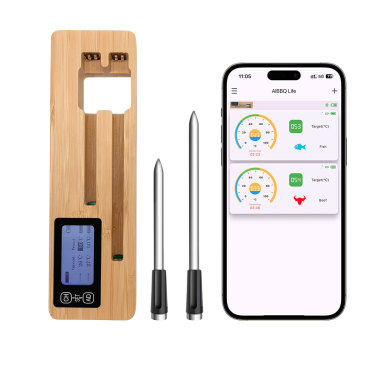Digital Meat Thermometer: The Essential Tool for Perfectly Cooked Meals

# Digital Meat Thermometer: The Essential Tool for Perfectly Cooked Meals
## Why Every Kitchen Needs a Digital Meat Thermometer
Cooking meat to perfection is both an art and a science. While experience and intuition play important roles, nothing beats the precision of a digital meat thermometer when it comes to ensuring food safety and achieving ideal doneness. Unlike traditional analog thermometers, digital versions provide quick, accurate readings that take the guesswork out of cooking.
How Digital Meat Thermometers Work
Modern digital meat thermometers use advanced temperature sensors to measure the internal temperature of your food. Most models feature:
- Instant-read capabilities (typically within 2-3 seconds)
- High-precision sensors with ±1°F accuracy
- Clear digital displays that are easy to read
- Waterproof designs for easy cleaning
- Long probes for reaching the center of large cuts
## Key Benefits Over Traditional Thermometers
Digital meat thermometers offer several advantages that make them superior to their analog counterparts:
1. Speed and Accuracy
Digital models provide readings in seconds with professional-level accuracy, while analog thermometers can take minutes to stabilize and are often less precise.
2. Programmable Alarms
Many digital thermometers allow you to set target temperatures and will alert you when your food reaches the perfect doneness.
3. Versatility
From rare steaks to fully-cooked poultry, a good digital thermometer can handle all your protein needs with preset temperature guides for different meats.
## Choosing the Right Digital Meat Thermometer
When selecting a digital meat thermometer, consider these factors:
| Feature | Importance |
|---|---|
| Temperature Range | Look for at least 32°F to 400°F coverage |
| Probe Length | 4-5 inches is ideal for most meats |
| Response Time | Faster is better (under 5 seconds) |
| Waterproof Rating | Essential for easy cleaning |
## Proper Usage Tips
Insertion Technique
Always insert the probe into the thickest part of the meat, avoiding bones and fat deposits which can give false readings.
Cleaning and Maintenance
Keyword: digital meat thermometer
Clean the probe thoroughly after each use with warm, soapy water. Never submerge the digital display unit unless it’s specifically designed to be waterproof.
Calibration Check
Test your thermometer periodically in ice water (32°F/0°C) and boiling water (212°F/100°C at sea level) to ensure accuracy.
## Recommended Temperature Guide
Here are the USDA-recommended safe minimum internal temperatures:
- Poultry: 165°F (74°C)
- Ground meats: 160°F (71°C)
- Pork: 145°F (63°C) with 3-minute rest
- Beef, veal, lamb steaks/roasts: 145°F (63°C) medium rare
- Fish: 145°F (63°C) or until flesh is opaque